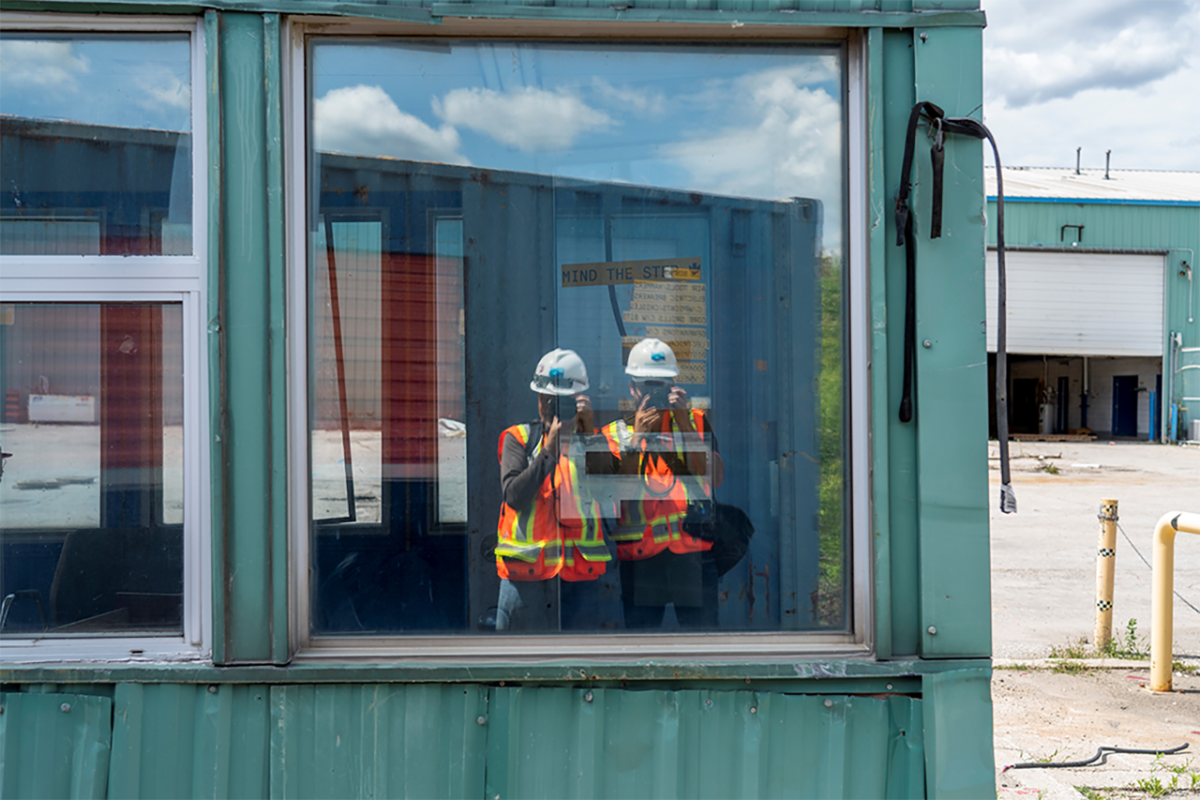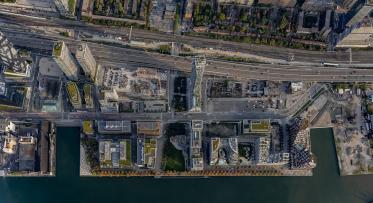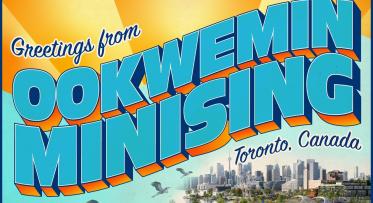How artists see the Port Lands project differently
Photographers Vid Ingelevics and Ryan Walker have been taking photos in the Port Lands since 2019. Here's what they think about this transformational project.
POSTED: FEBRUARY 9, 2023
If you follow Waterfront Toronto on social media, chances are you’ve seen one of the ‘Friday Photos’. These photos are taken by Vid Ingelevics and Ryan Walker, two professional photographers who we commissioned to document the Port Lands Flood Protection project. We sat down with them to get an artist’s perspective on the heavy construction that they’ve spent the last four years documenting.
WT: What attracted you to working on this project in the first place?
Vid: I’ve always had an interest in urban issues and the idea of the archive. My father used to work in the Port Lands, which struck me as an unusual connection to the site. I also worked there in the summers in high school. The opportunity to create a record that will be this significant for the City of Toronto, as an artist and photographer/documentarian, is a great challenge.
Ryan: I’ve always been interested in these forgotten spaces and exploring them by bike and foot - often with a camera. The Port Lands has a magnetism that was always bringing me back. It kind of felt like the wild west – anything goes. When I saw the Request for Proposals, I was excited about playing a role in the massive transformation. I don’t think I could grasp the sheer scale of this project and how significant it was.
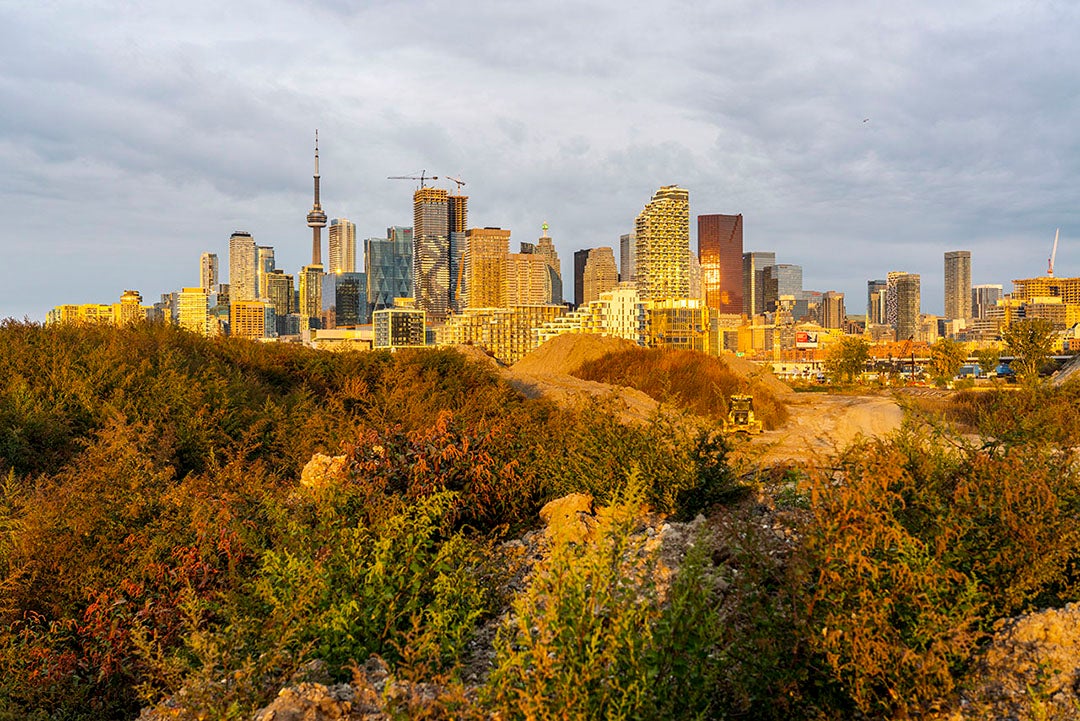
This photo, taken at sunrise, captures some of the wildness that attracted Ryan to the site.
WT: Why did you decide to team up?
Ryan: We attended some of the information sessions to learn more about the project. We started to realize how unbelievable the scope was. I was excited to work and partner with Vid. He was one of my professors at TMU. We had been in contact in the photo community off and on. I saw the value in working with someone like him and his attention to detail and his fascination and experience with the archive.
Vid: It was mutual admiration. I knew Ryan as a grad student and the project that he did impressed me. I knew the kind of meticulousness and care that he brings to his projects.
The joke is that we thought it was too big for one person, so let’s collaborate. And now we realize you could probably have a team of 10 operating down there and still not capture the full scope of it. We’ve had to come to grips with the idea that we’ll never be able to represent the entire project.

High-visibility vests are a blessing and a curse for the photographers. While they can dominate close-up photos, they pop in the landscape and provide a sense of scale.
WT: Why do you think it’s important to document the project?
Ryan: This project is such a transformative moment for the city. The public isn’t going to see the bioengineering and layers that exist beneath the surface. The importance of this documentation is to capture this moment in time and to see the lengths that the engineering and project team and landscape architects are going to, to ensure that this is done right.
Vid: Documenting a project like this is so important because it happens so rarely. The photographs that result are often useful for far more than “how did they dig the hole?”. What happens over time is that all the elements in the photo become significant, not only what we originally thought to be the ‘subjects’ of our images.
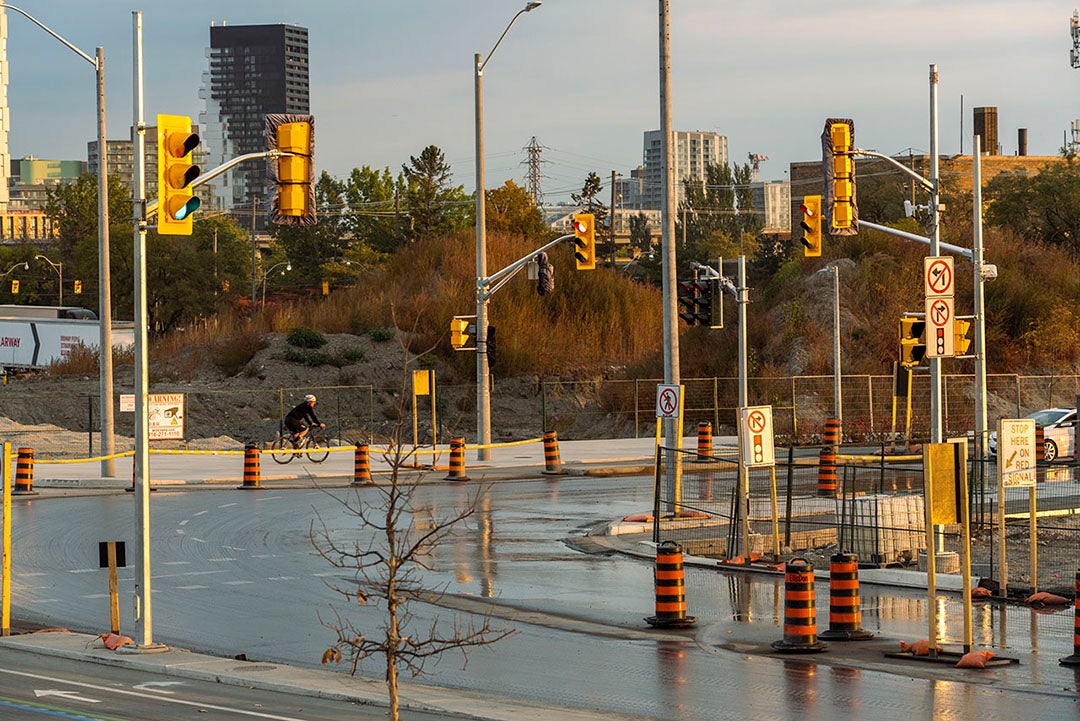
While the opening of the Cherry Street South bridge has given the public a glimpse of the project, they will never get to see the complicated bioengineering integrated into the river.
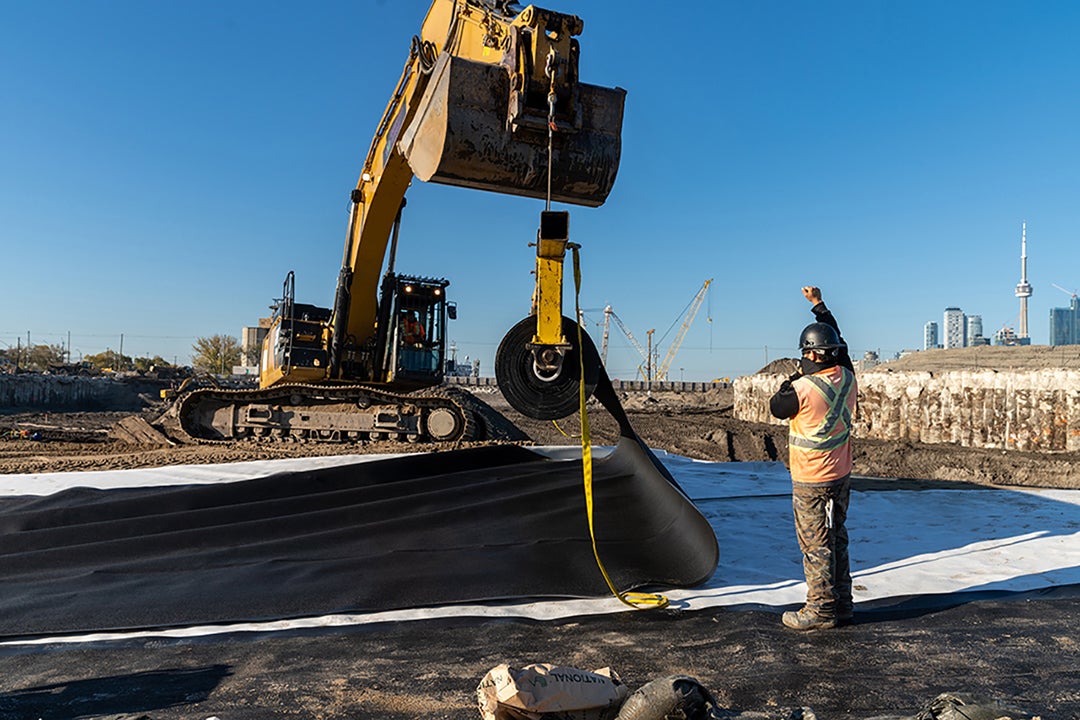
Deep underground, the river valley is lined with layers of material to prevent
contaminants from seeping up into the new river.
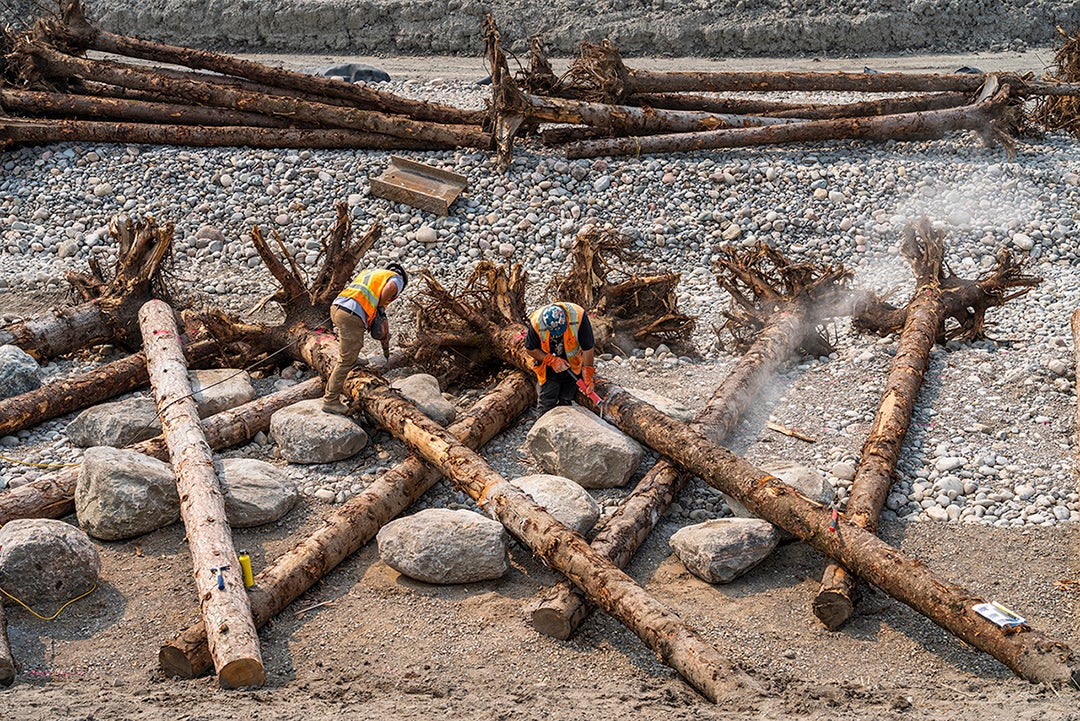
Several layers of these crisscrossed logs are built into the sides of the river channel. The boulders and the tree trunks are buried and no longer visible.
WT: So, it’s not very common to have big projects documented like this?
Vid: The City of Toronto Archives has commissioned projects in the past. When they did, they produced important records of how a city develops. One notable example is Arthur Goss, the first photographer hired by the City of Toronto in 1911. He did the famous documentation of the Bloor St. Viaduct. They are fantastic images and a model for how one might carry out this documentation. Michael Ondaatje wrote a book based on them that became a best seller, In the Skin of a Lion. The Port Lands project is easily on par with the civic ambition that characterized the construction of the Bloor Viaduct. It has a similar timeframe and scale, too.
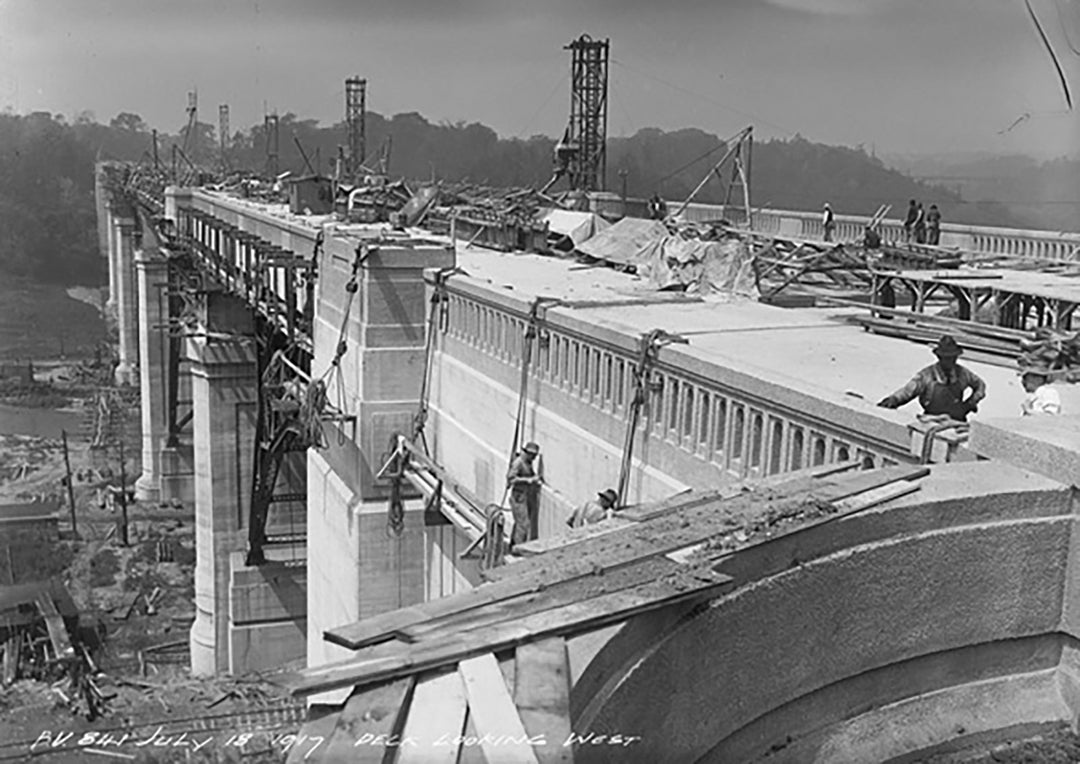
Arthur Goss’s photos of the Bloor St. Viaduct set a precedent for documenting
major transformations in the city. Photo: City of Toronto Archives.
WT: What was it like when you started the project?
Ryan: That first year it felt like we were playing catch up a little bit, because construction had already started. We’re documentary photographers, long-form storytellers. Ideally, we would have started photographing this project in 2016, photographing the post-industrial space as it existed and was operating up until that time. We were still able to capture the essence of that with some of the remaining buildings and businesses. We like to think of that first year as the year of destruction. It was tearing the buildings down, flattening the land.
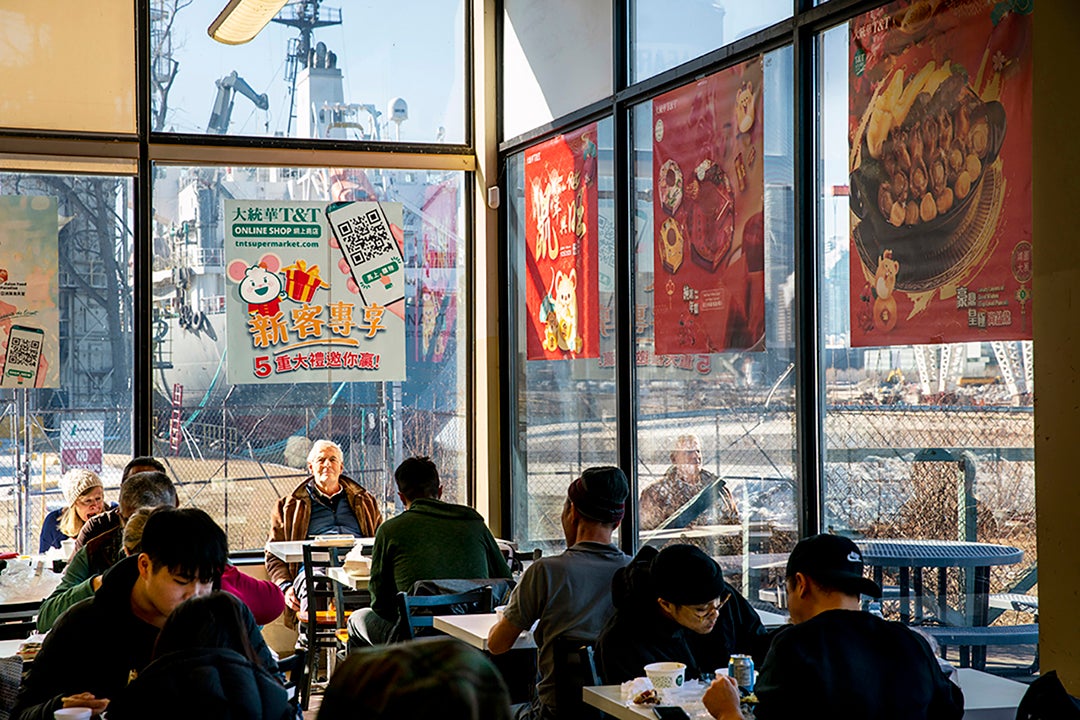
Taking photos inside places like T & T, which was in the path of the new river, before it closed allowed the photographers to capture some of what the area was like before construction took over.
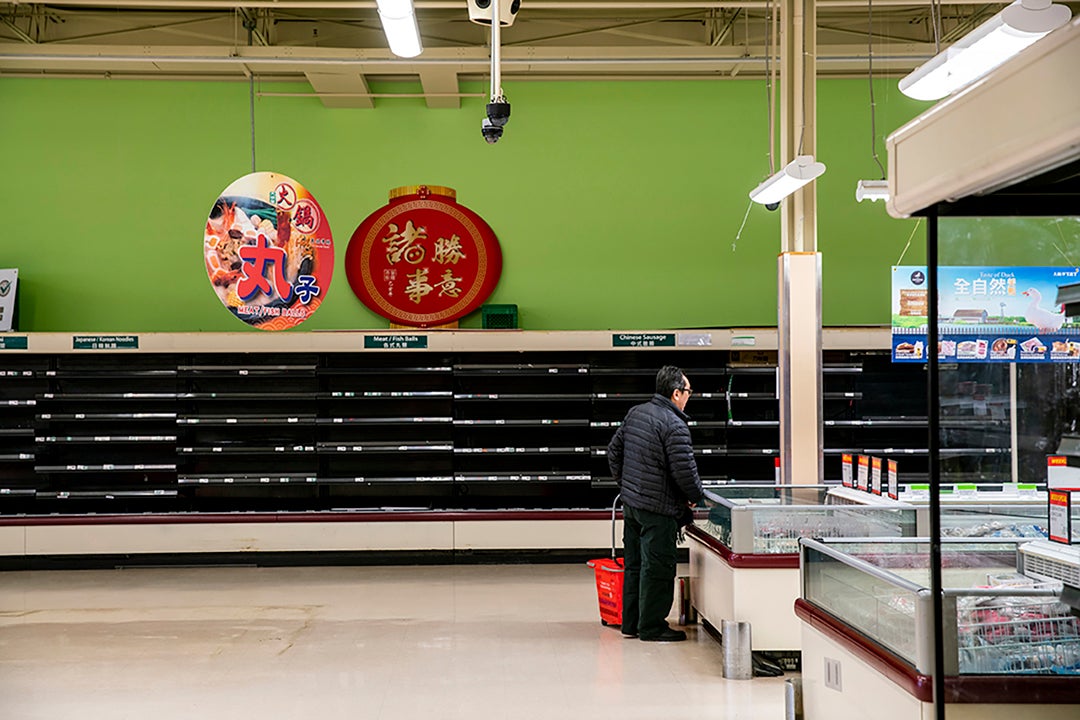
This photo, taken just before the T & T closed, is part of the story of the Port Lands’ transformation.
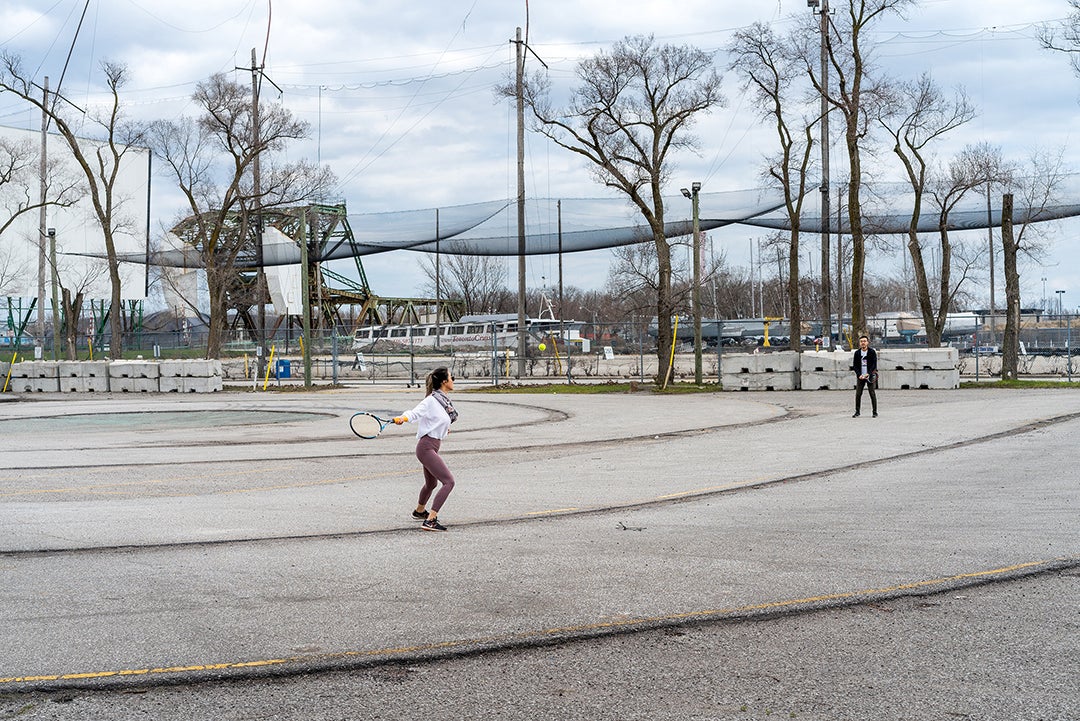
The Port Lands Flood Protection construction site is only in one part of the larger Port Lands. The photographers were able to capture the atmosphere pre-construction in the areas that are outside the project footprint.
Vid: I was surprised by how much demolition happened at the beginning. We covered that carefully. The primary example for both of us is 130 Commissioners St. From the outside it looked like a collage of a building. Under that, there was this massive, beautiful hall in the centre. Maybe it wasn’t, but it looked to us that it could have been salvaged and would have made an amazing pavilion. Maybe that’s not positive, but that’s part of what it means having artists on the site. That was the theme of our first CONTACT exhibition. We began with the question, “how do we designate industrial heritage in the City of Toronto?” That’s an open discussion. If we were able to prompt any discussion of that we’d be happy.
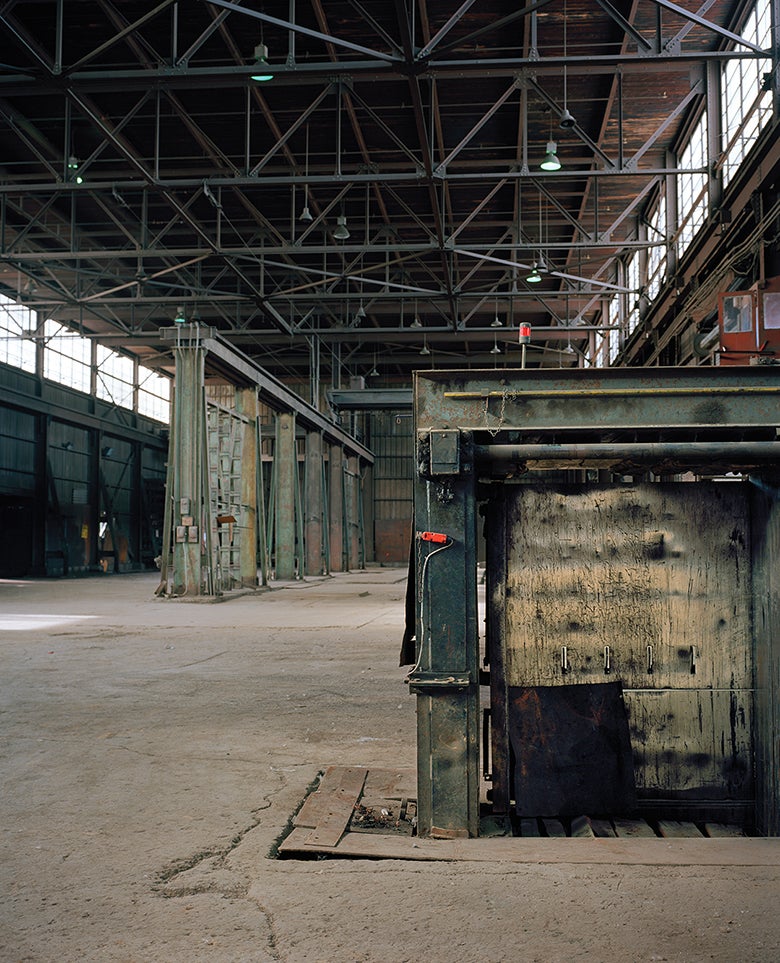
Inside 130 Commissioners Street. See more about 130 Commissioners in their CONTACT Photography Festival Archive and this online presentation.
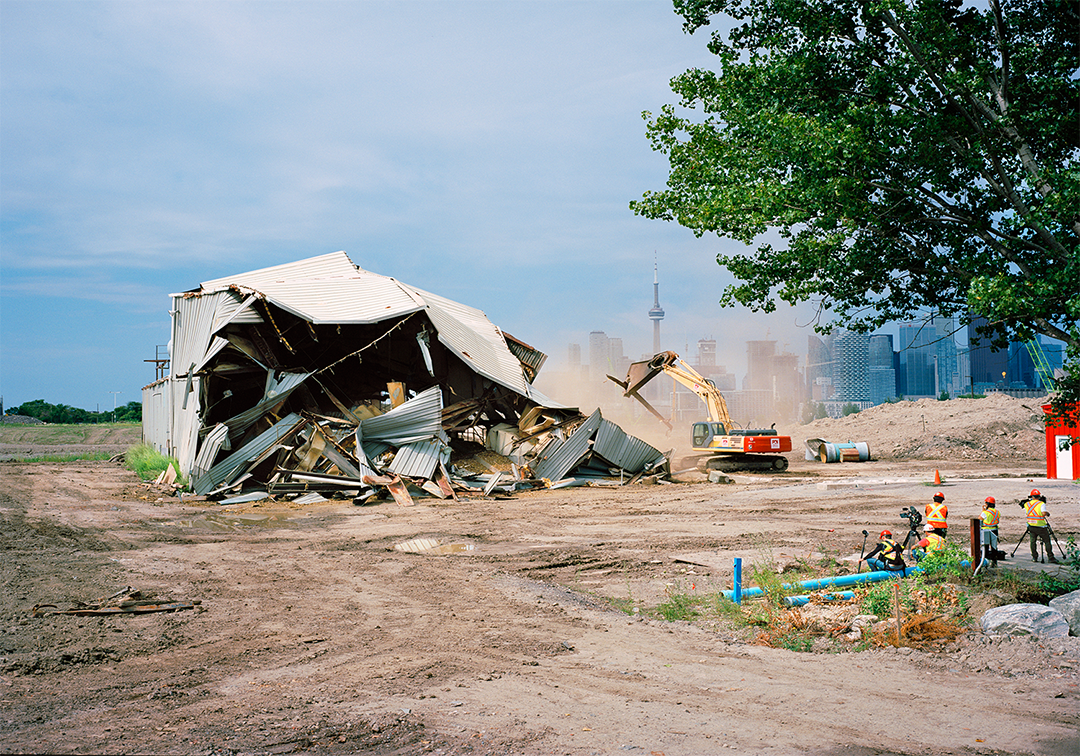
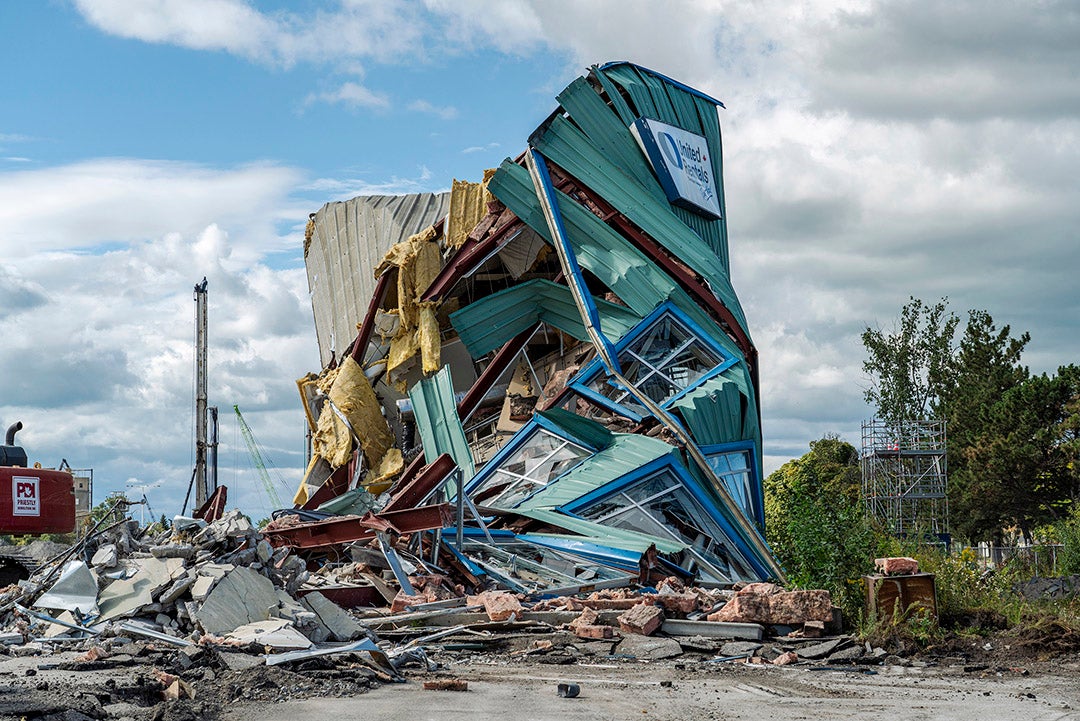
Vid and Ryan were surprised at how many buildings were demolished in the first year of construction. Most were in the path of the new Don River.
WT: What has surprised you over the course of the project?
Ryan: The workforce. We’ve been able to develop relationships with those on the site. People wave to us and call our names. It has also surprised us in terms of its diversity. Everything from ethnicity, socioeconomic backgrounds, gender identity and the various roles that everyone plays. For us, that’s something that we are really interested in representing.

Often the workers are proud to be featured in a portrait. One even approached Vid to show where his photo was featured on the Port Lands project website. See more portraits here. L: Natalie, Stantec, environmental team. R: Jude, Quantum Murray, equipment maintenance.
Vid: We’d made certain assumptions about who’s on a construction site, and we realized it’s a lot subtler than we ever imagined. It’s been a privilege to get to know people on the site. These are long-term relationships in a way. Some of the people are working there for the same length of time that we’ve been there, which is years.

L: Sal Jr. and Giovanni were part of the EllisDon crew that built a new hotdog stand for a local vendor after she had to relocate her cart. R: Terrence Graham, cement truck driver
WT: Are there any moments that have stood out to you so far?
Ryan: Obviously, the 100-year-old seed story is amazing. The resiliency of nature in general as well. It wasn’t surprising, but it was pleasant to see that every summer the mounds of soil started to flourish. It was with weeds, but the pollinators are out, the weeds are growing.
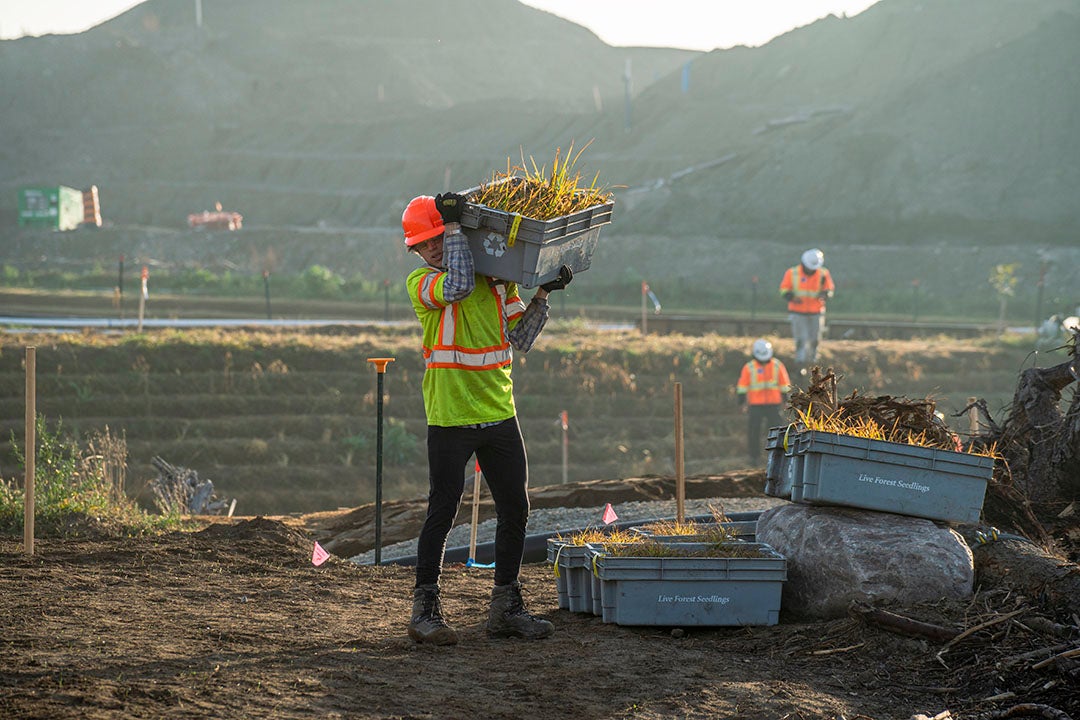
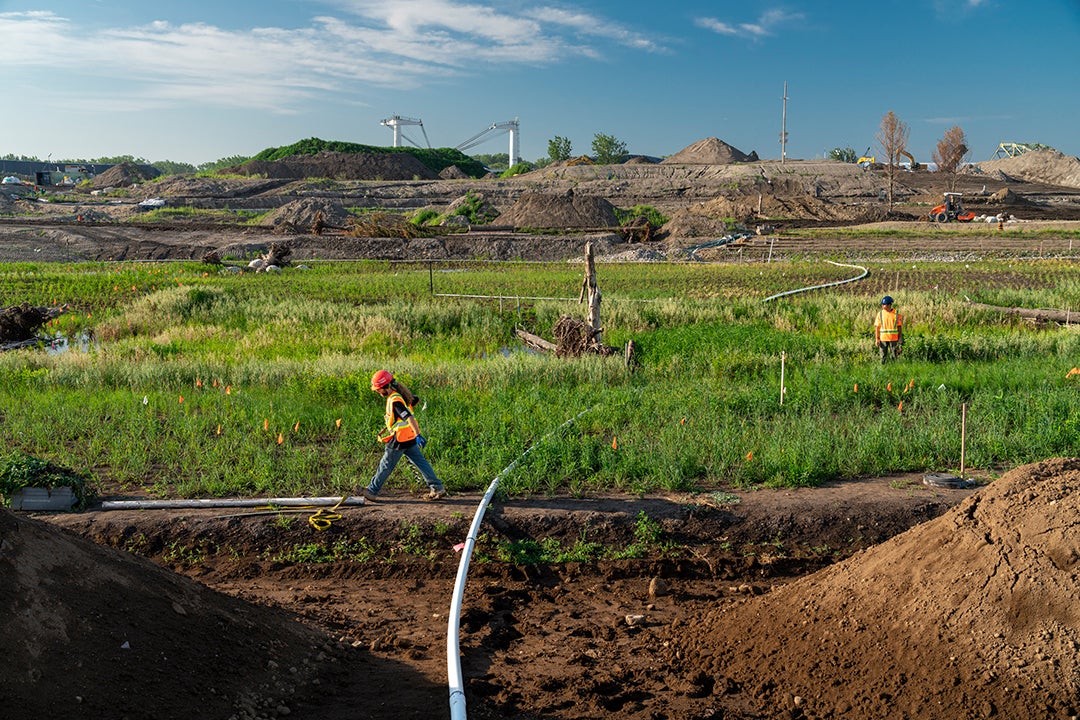
Seeing plants arrive has been exciting for everyone! Learn more about what we’re planting here.
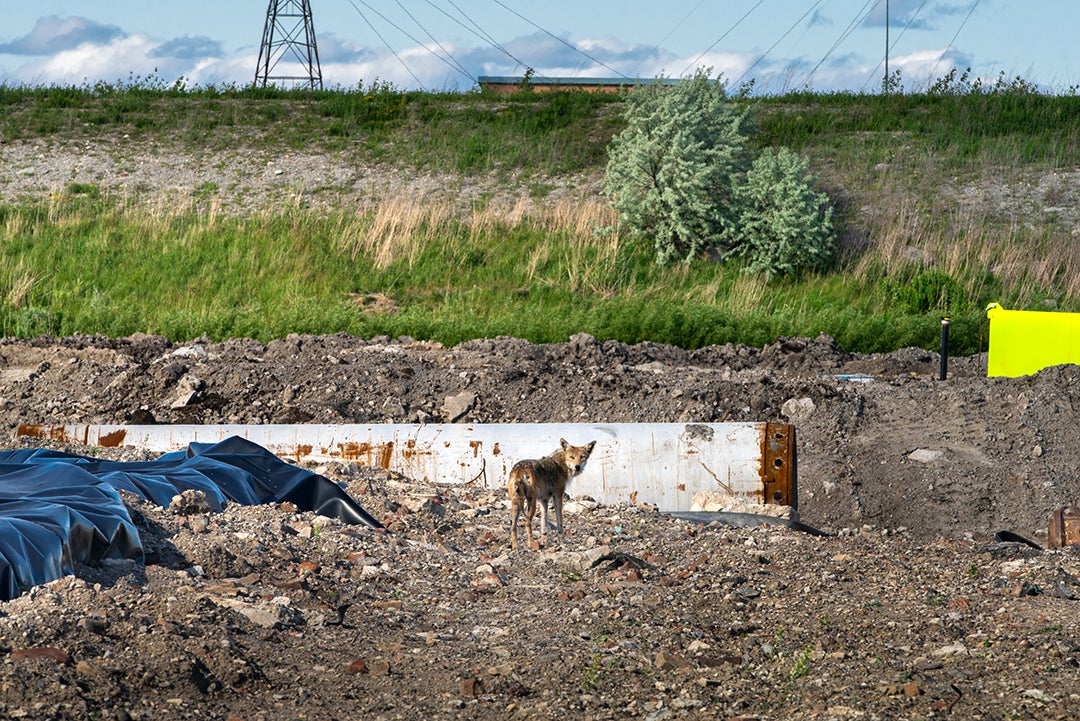
Coyotes have been spotted on site, possibly attracted by the mostly empty land. So far, our environmental management plans have ensured there are no human/coyote conflicts.
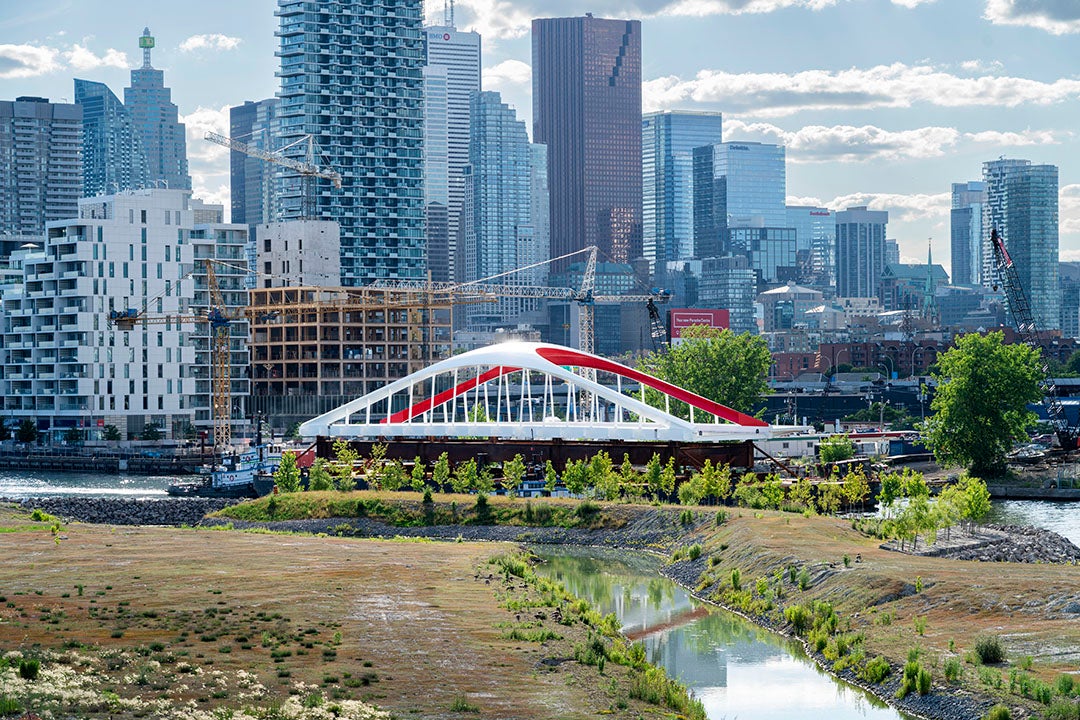
The arrivals of the new bridges is something people can appreciate from outside the construction fences.
Vid: It was fascinating to see the breakwater that used to link Fishermans’ Island to the shore uncovered during excavation. Finding the garbage dump with the bottles and old objects that came out of it was quite exciting as well. We have 100-year-old seeds and a 100-year-old doll’s head. The two things, in a weird way, are coexisting.
Ryan: The construction folks will hate hearing this, but we’re pleasantly amused when nature halts progress, like the nesting birds in the T&T building.
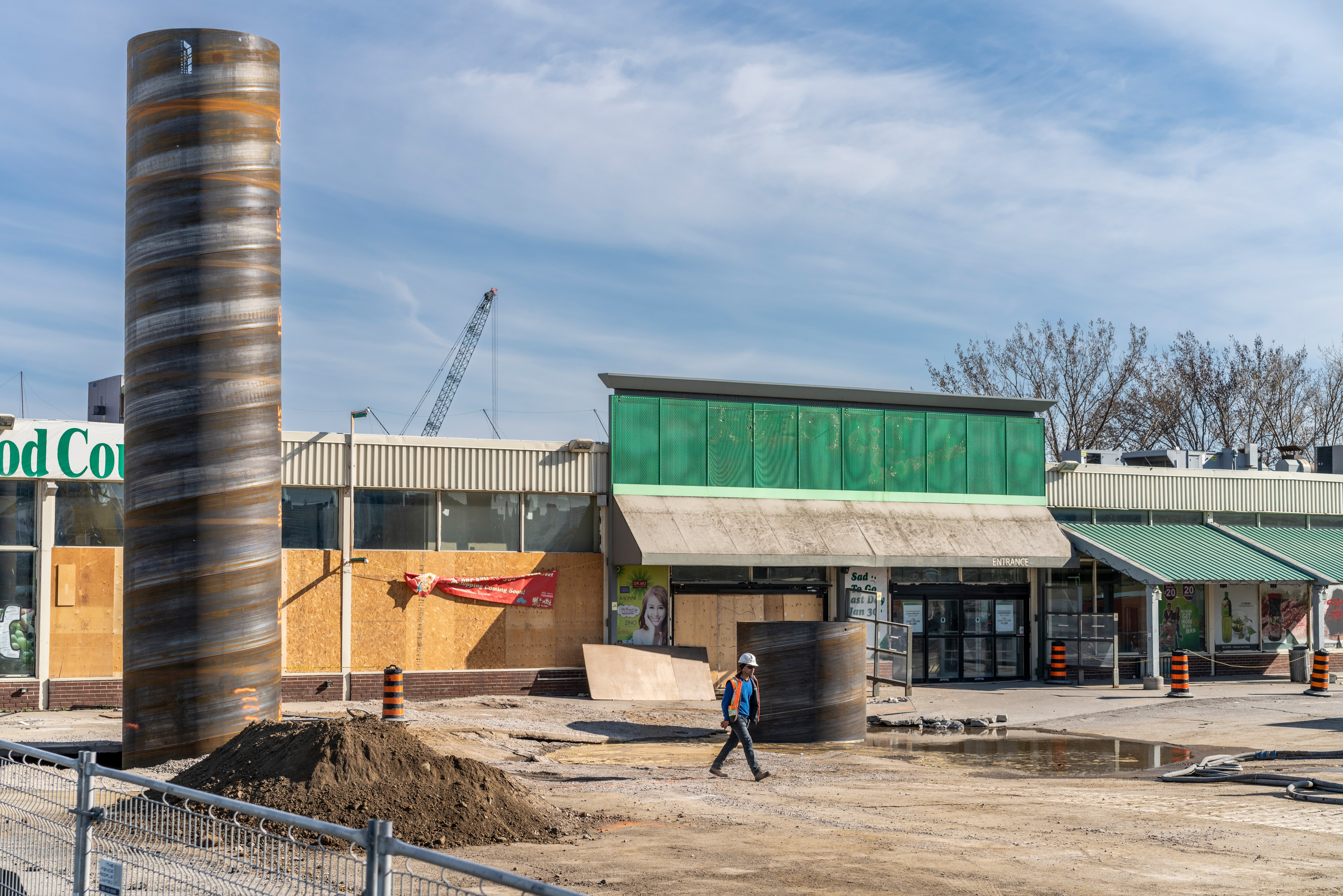
The front façade of the T&T building was left standing long after the rest of the building had been demolished because of birds nesting in the awning. The large pipes sticking out of the ground are caissons – structures that now support the Cherry Street South Bridge.
WT: What are your favourite elements to capture?
Ryan: As we reflected on our archive, we’ve identified themes and subcategories of images. Labour and the workforce is a favourite for me. We’re also interested in how folks interact and communicate with one another. Sometimes it’s through hand signals to communicate over the loud machines. Sometimes it’s verbal communication. Sometimes it's physical expression. The last few months on site I’ve seen people hugging.
Over time we can compare similar views and panoramas. That is quite fascinating and gets us excited.
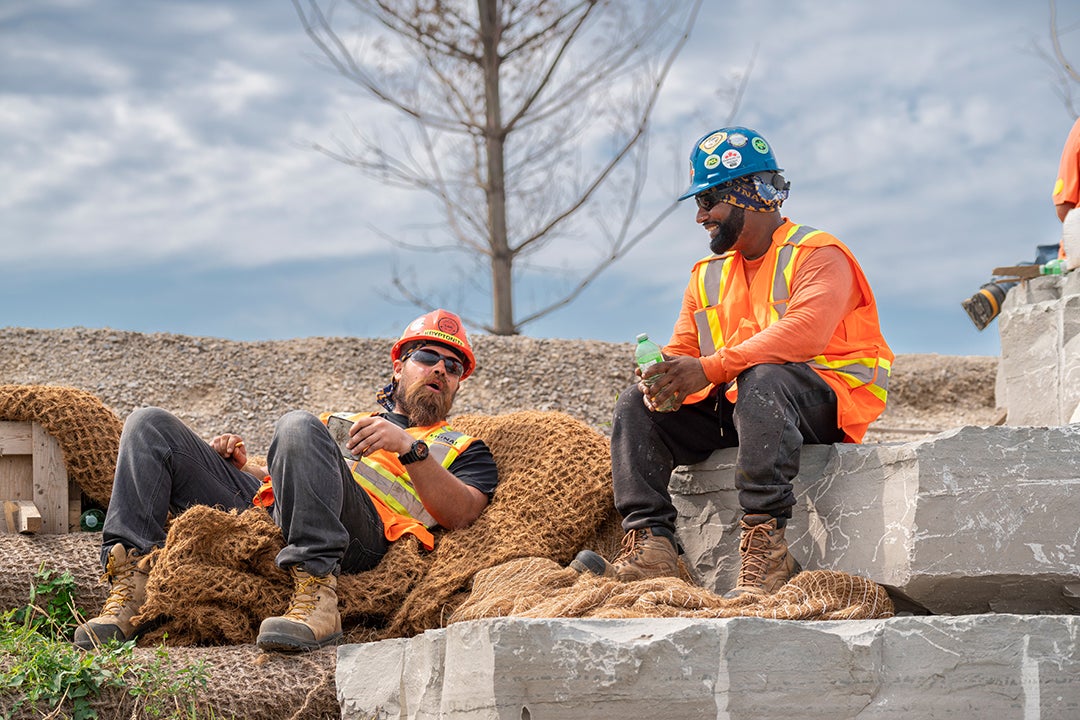
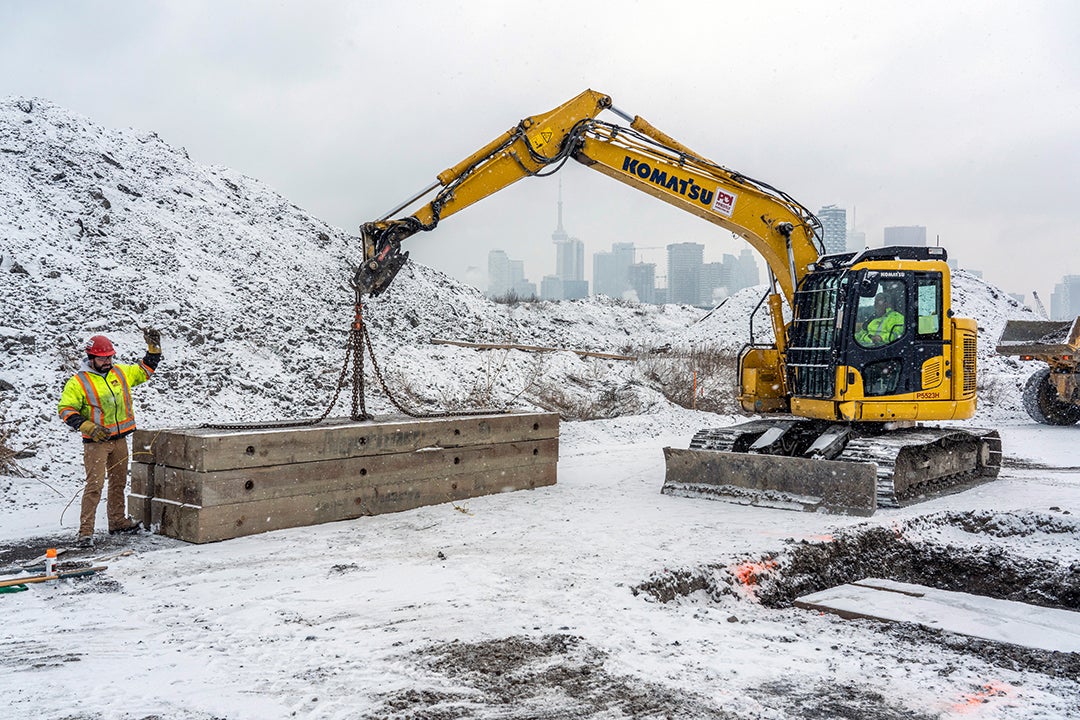
While the Port Lands Flood Protection project is exciting on an environmental level, the human connections are most compelling for Ryan and Vid.
Vid: The contrast between heavy machinery and hand planting is my favourite. Machines are still there but not dominating the site the way they used to.
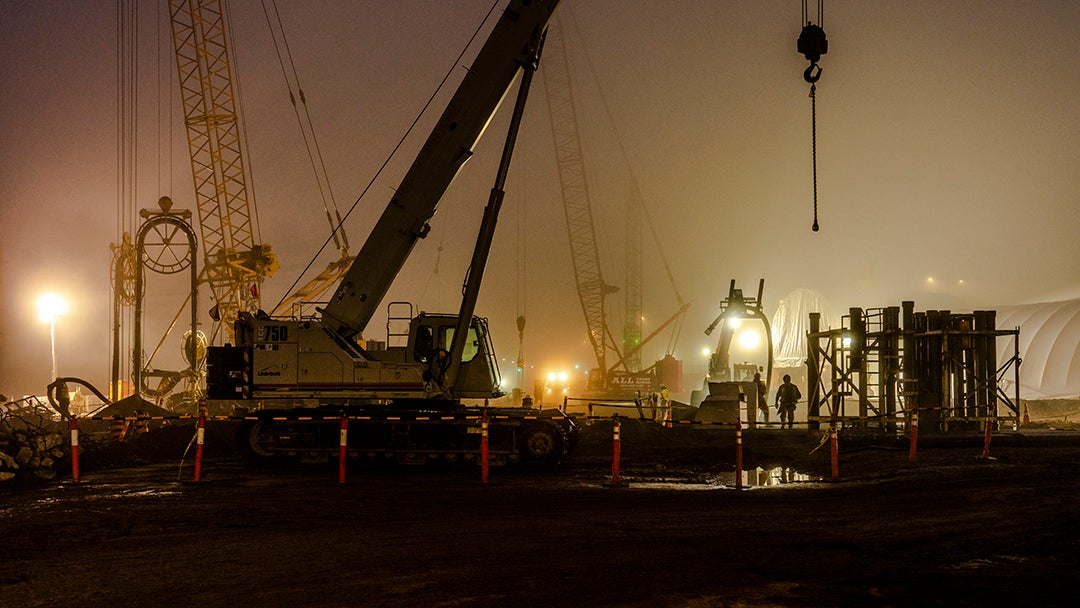
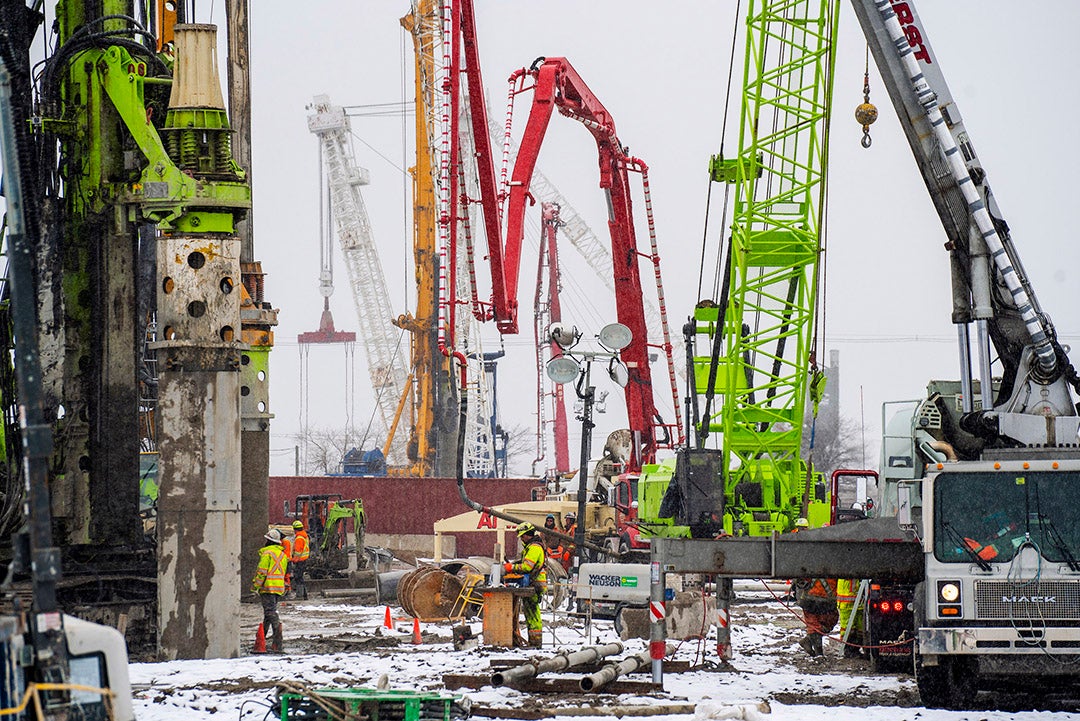
Early in the project the entire site was full of giant machines and earth moving trucks.
WT: How does your prior experience feed into your interpretation of this project?
Vid: Both of us have backgrounds as documentary photographers, but also as visual artists. We can bring a conceptual sort of thinking to some of the work. In the RFP, they explicitly wanted photographers to document and interpret what they were seeing.
Ryan: Our job isn’t done when we leave the site and send the photos to Waterfront Toronto. As artists, we’re constantly thinking about how to contextualize our work and to represent a specific element of the story. Half the work is just looking at the photos and talking about it and working through various forms of presentation and interpretation.
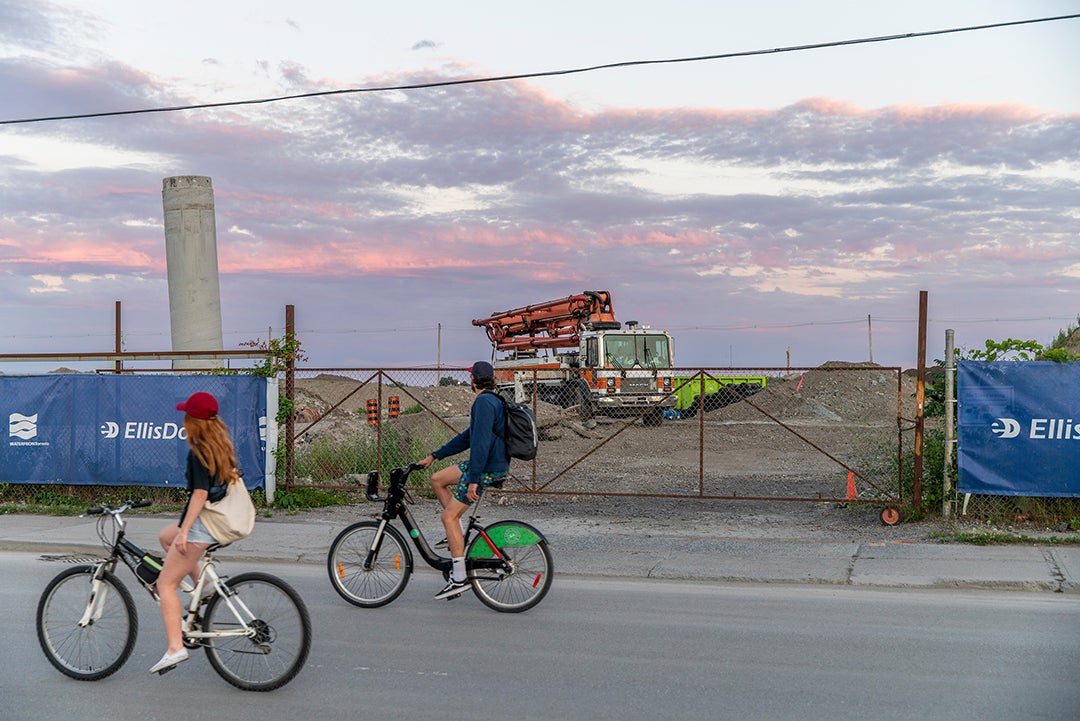
During the height of the COVID-19 Pandemic, the photographers were asked not to come on site. That forced them to view the project from a different vantage point – outside the fences.
WT: You’ve taken some amazing photos, some clearly document a specific aspect of the project, while some are more abstract.
Vid: One of our categories is ‘the anti-industrial’. It’s a bit tongue in cheek but for us that doesn’t mean it’s against the industrial, it’s more that the images are unconventional and somewhat difficult at first to understand. It’s hard to explain, they’re still visual images, but they’re ambiguous. The ambiguity of them is fascinating. These kinds of photos are what results when we, as artists, are not restricted by a client’s wishes, in the way a professional industrial photographer would normally be.
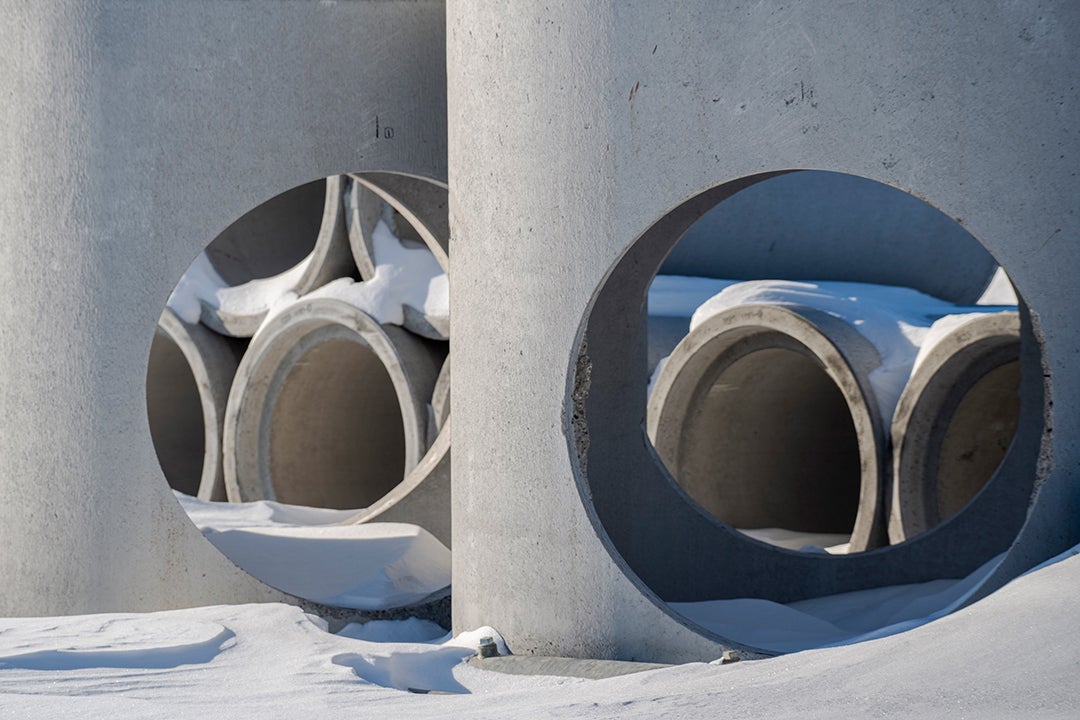
Photos like this one showcase Vid and Ryan’s less conventional approaches to the site.
Ryan: You’re unsure what you’re looking at, but you want to know more. We call them anti-industrial photographs because they’re the images the construction crews would see and say “what the heck is this? Why…?”.
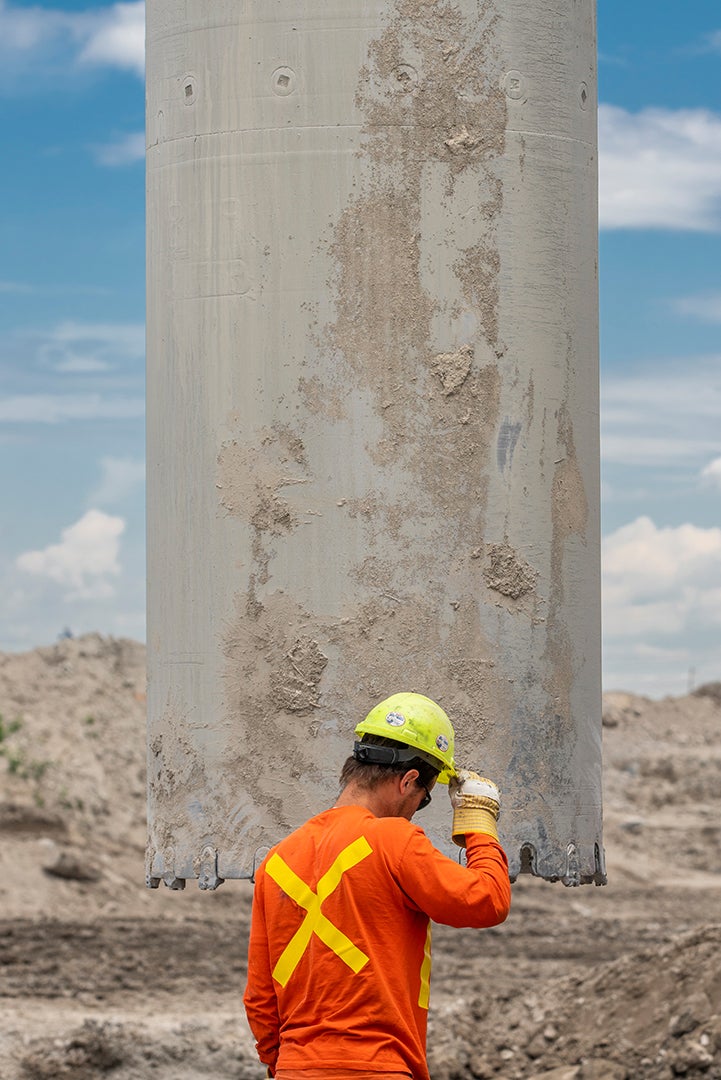
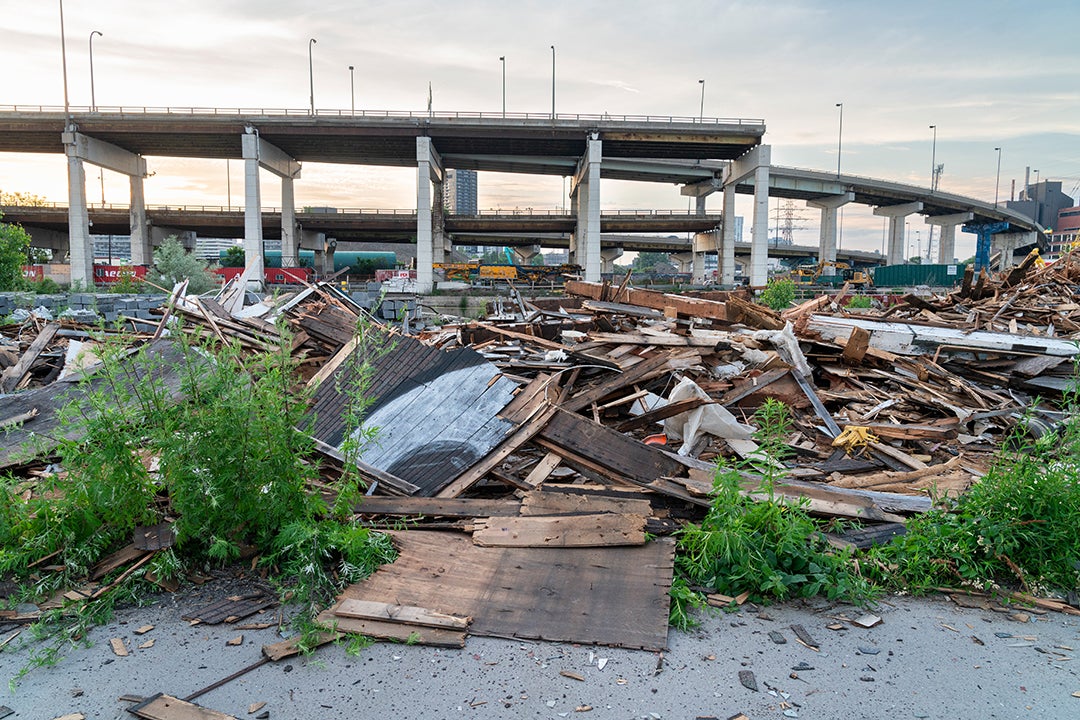
Some of the photos that Vid and Ryan classify as ‘anti-industrial’.
Vid: They aren’t necessarily about something, but they create a response. The expectations one brings to images, especially in a documentary genre, is that they’re going to tell you something right away. So sometimes it’s fun to push back against that notion that we’re just going to give you, the viewer, everything instantly in every picture.
We hope that these images expand how we might look at a vast construction site like the Port Lands through proposing a range of ways of seeing it, some unconventional. This is the great thing about being commissioned as artists - that these kinds of images are important, too. Not everything needs to be self-evident.
WT: What are you looking forward to as the project progresses?
Ryan: The further greening of the site. As a photographer, a lot of the projects that I’ve made in the past, at the root of it, are exploring the idea of nature and our identity.
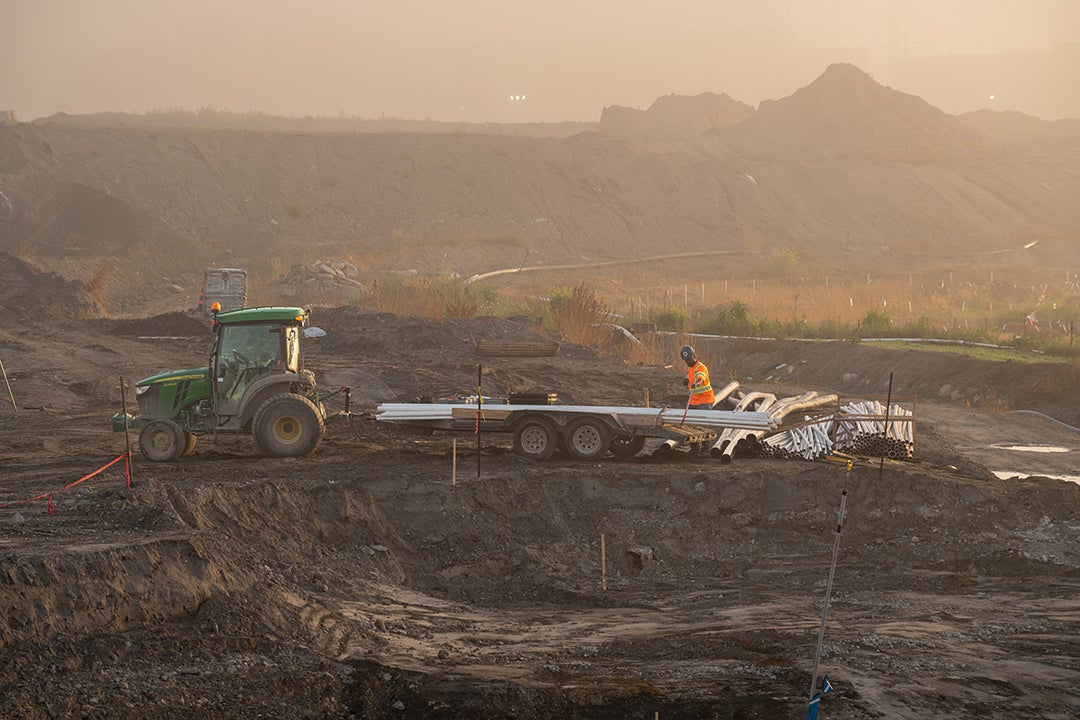
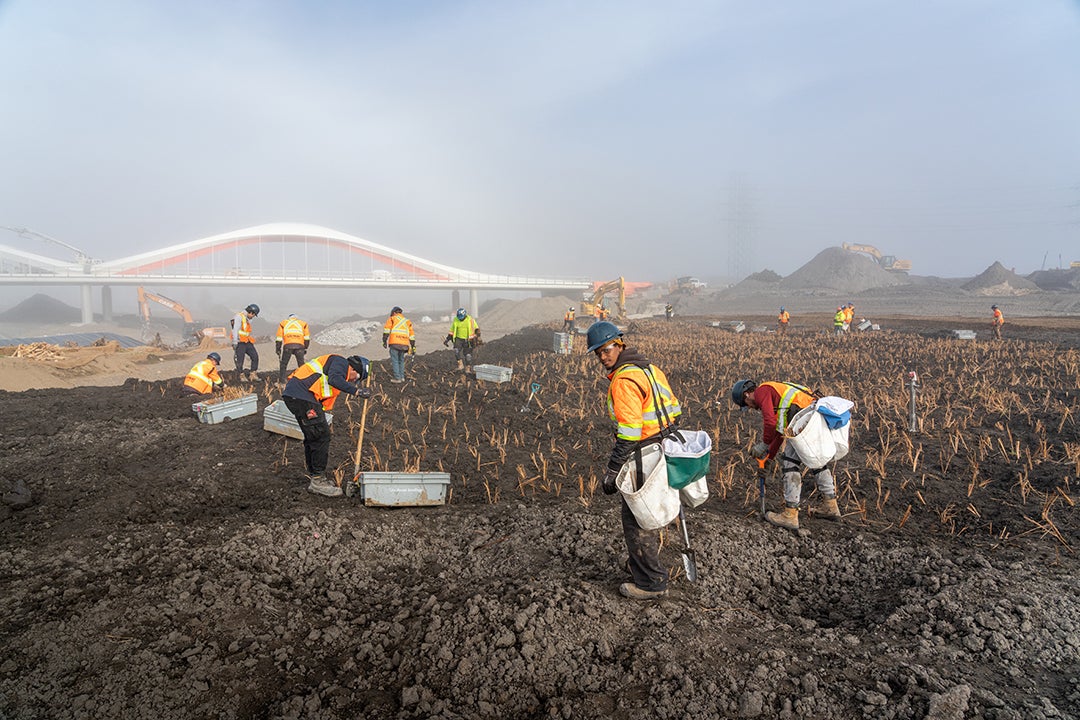
As the site becomes greener, the contrast between machines and large planting crews is apparent.
Vid: Starting to engage more with the Indigenous community. When we went to plant the seeds that had been grown from the historic seedbank, that was really moving and unusual to see on a construction site.
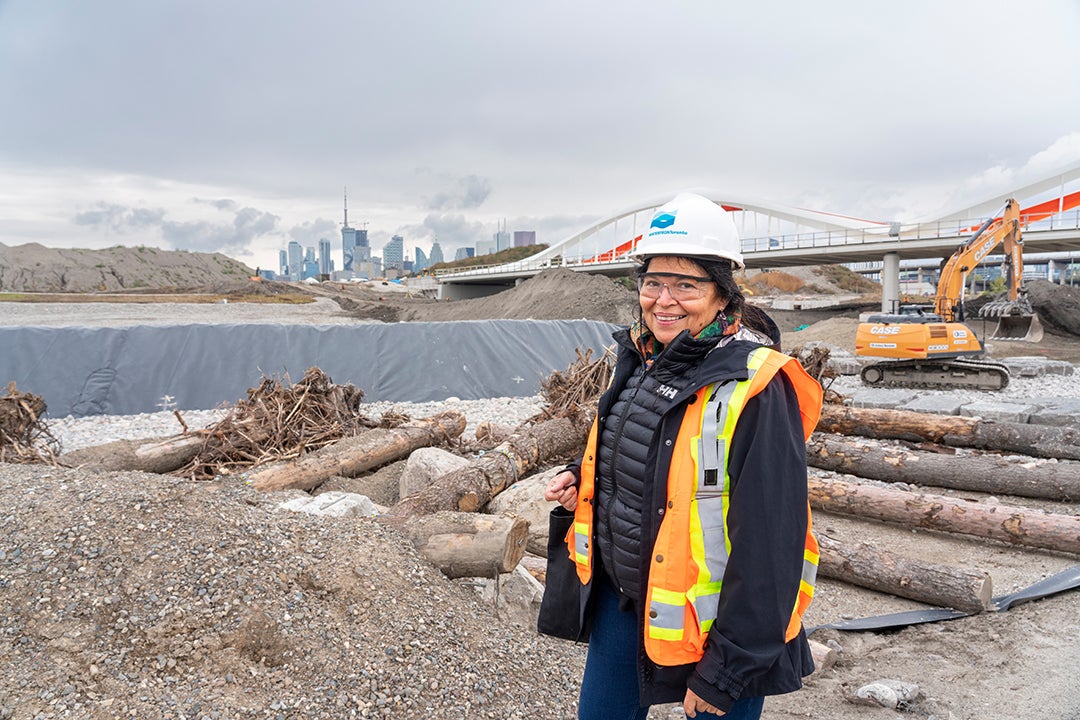
Shelley Charles, an Indigenous Elder and consultant with MinoKamik, encouraged the team to pause and consider the significance of the project before restoring some plants grown from the 100-year-old seeds we found to their original location.
WT: Is there anything else that you think you might have missed?
Vid: The people who work in management or at desks in the corporate office. Why are they not part of our documentation? In some ways, when you [Waterfront Toronto staff] let us loose on the site, you’re potential subjects, too.
Ryan: We need to start an office series. Maybe when the weather goes south. We’ll find you in your office cubicle. There are so many different roles. We still need to acknowledge that there are so many moving parts behind the scenes. Folks at computers, at desks, in big meetings, public consultations, etc. All those things are part of the success of the project.
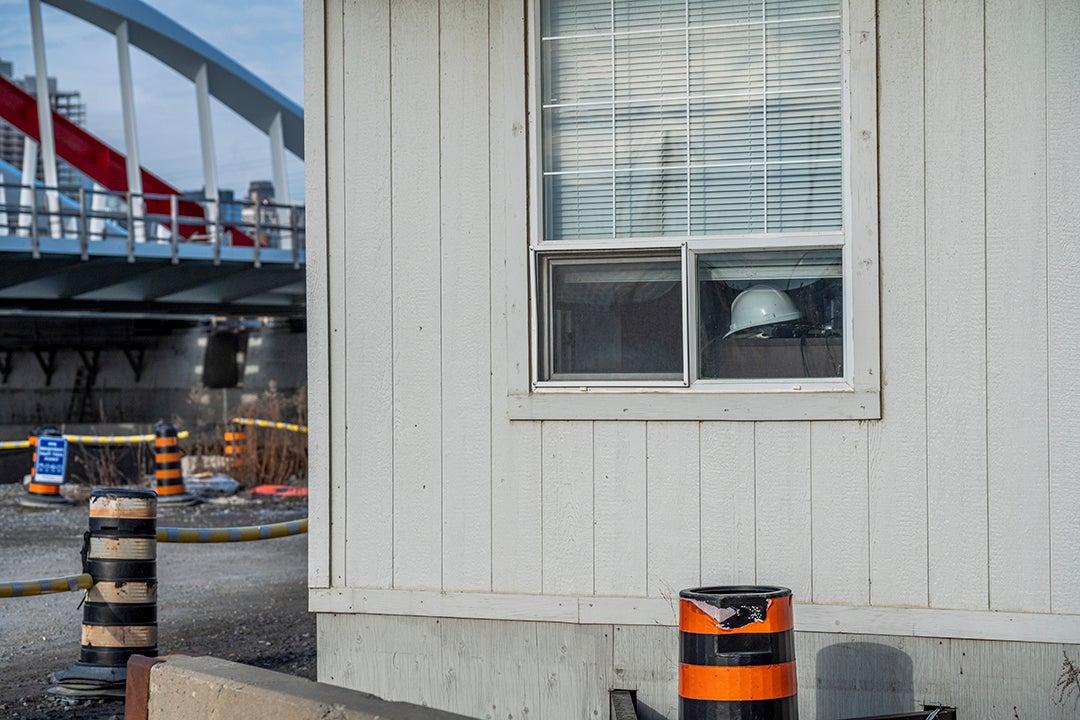
The photographers want to include some photos of the management and office workers in their archive, as they also play a role in making this project happen.
This interview has been edited for length and clarity.
Follow Waterfront Toronto on social media to see more of Vid and Ryan’s photos. You can find us on Twitter, Instagram, Facebook, and LinkedIn. You can follow the photographers on Instagram : Vid is @artinfact_0052, and Ryan, @RyanWalkerPhoto.

